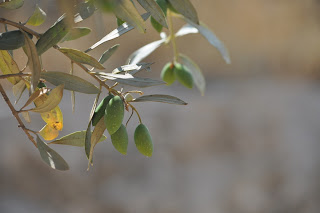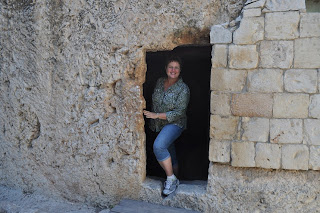I had been looking forward to attending the Adventist Church
in Jerusalem. I envisioned a modest little church in the shadow of the ancient
religion of which we claim to be the purest modern manifestation. God called
Abraham and continued to labor with His people through His law and His prophets
and finally through His only Son. Our church sprang up as a response of love to
and a desire for the One emptied heaven to save His children; the One who
promised to make a new heaven, a new earth, a New Jerusalem.
I should have remembered my excitement to worship with the
Chinese during my years as a student missionary in Taiwan. I expected to see a
church packed with Chinese people singing their hearts out to some pentachromatic
Asian-sounding music hailing God as supreme, the lover of the Chinese soul. How
disappointing it had been to hear them plodding through the same Western hymns
I had sung from youth. The words were Asian, but the feel was Caucasian. Our
hymns were a response of the European and American soul to the universal God. I
was hoping for a taste of the Asian soul expressing its deep devotion to God in
uniquely Asian ways.
My disappointment with the Jerusalem Seventh-day Adventist
Church was immediate, though along slightly different lines. The service was
more Jewish than the Taiwan services had been Chinese. What was missing were
the Jewish people.
The sanctuary was small, long and narrow, simply but nicely
decorated with Jewish trappings.
There were yarmulkas waiting by the door for those who
wished to enter God’s presence with covered heads, and in front were Bibles
written in Hebrew and Greek. There was even a cabinet resembling the Torah arc found in
synagogues.
The Mr. and Mrs. wanted their picture taken in that setting
and though I objected, they insisted. When I snapped the picture I saw that
they had climbed right up on the Bible! A stunt that earned them a ride in the
BOTTOM of my backpack for the rest of the day.
Though many hymns were familiar, some songs and recitations
were in Hebrew. All that was nice. But the people…
Most of the 29 people in attendance were Filipino! Many were
working in Jerusalem as caregivers of the elderly. And they were excellent
caregivers for the wanderers who come through their church. I feared the strain
the 13 of us visitors would put on the remaining 16 members when it came to the
potluck. But they freely invited us to join them. I whispered to Ginger that we
needed to leave. She surprised me with a resolute answer: “Jim, I have one word
for you, ‘pancit’.” And that settled it. After two weeks of Mediterranean
cuisine she was in the mood for food from her childhood.
The people were generous, kind, and engaging. We were even
joined by a Jewish rabbi from Cleveland! She was in Jerusalem studying with the
ultra-orthodox Jews who had made room for her, but really didn’t know what to
do with a female rabbi. They had no quarters in which she could reside, so she
was lodging at Advent House, the guest apartments adjoining the conference
office (which adjoined the sanctuary in which we worshiped.)She had been at the
Western Wall in the morning, but hurried back for church and potluck.
The conference leadership had also seen to it that Torah
scrolls were on the doorposts declaring our reverence for God’s holy law. So,
yes, the Adventist Church in Israel has taken on more of the Jewish flavor than
the Taiwan churches had managed to retain of the Chinese flavor. But in Taiwan
the churches were packed with Taiwanese, Mountainese, and Chinese.
But beyond the makeup of the Church in Israel, I have a
different feel about the Seventh-day Adventist Church overall. I still love my
church, and I do not feel tempted to turn from the Bible-based beliefs that we
hold. I am glad that we keep the Bible Sabbath, that we haven’t adopted the
Hellenist view of hell, and that we have shed some of the other pagan infusions
that have been added since Christ ascended. But my emotional response to my
church has shifted. I see it now in the context of the last 2,000 years, and
much of our behavior and our attitude seem thin like soup that has been watered
down. I am a little more aware of how Jewish Jesus was and how we read and
explain Him as though He were an American who traveled back in time to set those
people straight. We don’t hear Him the way people in His day would have heard
Him. We don’t see that He was a Jew living and breathing and thinking and
speaking in a pond of a different flavor than ours. So how much of what He said
are we really grasping? How many of our practices are more reflective of
American culture than the Christian essence? Considering the thousands of
cultures that have embraced and applied His teachings, it seems that our
smugness as the remnant is a little arrogant. It ignores the richness of what
has gone before. It allows us to think we are far closer to perfection than we
can possibly be. We are just one more group in desperate need of a Savior. I
still believe that our doctrines are better aligned with correct Bible understanding,
but our hearts are not much better than the Pharisees who also focused on being
accurate and true to God’s original intent. We can be just as ungodly in our
clinging to our “truth” as they were. In regard to doctrine-driven practices
Jesus told them, “These you should have done without ignoring the weightier
matters of the law: justice, mercy, and faithfulness.” I’m afraid if He were
here, He would have the same rebuke for us.
I am particularly ashamed of those of us who think we are
defending God’s last thread of belief. The more radical and fundamentalist we
go, it seems, the farther we stray from the Spirit of Christ. Right now the
Walla Walla Valley has a small group that has become very vocal about the
“apostasy” of some better educated ones in the valley. They are causing real
damage as they have become “accusers of the brethren.” They do so as ones who feel that they
know the mind of God, but in the methods they use to wage their holy war, they
look more like the Crusaders than Jesus. They have wrung the life and warmth
from Christ’s amazing gospel and are left with cold and lifeless words that are
used like cruel stones. They represent a self-absorbed, vindictive Adventism
that I hope never becomes our majority voice.
So what must I do? As always the answer is not in looking at
the offensive ones, nor focusing on combatting them. I am resolved to continue
loving Jesus and the Father He points us to. I want to keep myself pure from
the world as His apostle’s preach. I want to use the broader view gained during
this trip to make me broad. I want to have the heart of Jesus towards others,
while keeping His single-minded commitment to the mission. I want neither to
become legalistic nor permissive nor culture-blind. The One God is a huge God
and I am a mere speck. I would like to be a speck that understands my smallness
and refrains from faulting other specks. I want to let my light shine, but it
is a very humble light.
We walked home from church and on the way Ginger found
another sculpture with which to interact.
After a short stay in our hotel room, we took off for
another visit to the Mount of Olives. People from around the world are buried
on the mount in hopes of a favorable resurrection when Jesus returns, or when
the Messiah finally comes, or… whatever prompts the Muslims to do the same.
On the top of the mount another “mount” was waiting… your
trusty camel. Yup right here in the heart of Jerusalem.
We returned to the olive grove that may have been the site
of Gethsemane just to have some time for reflection. Ginger and I found
separate places to sit, think, and be.
Ginger’s spot is in a garden kept by the Mormons I believe.
I didn’t ask her what she was thinking. It was a good private time.
What was I thinking? Not a lot of lofty thoughts. No, I was
mostly just sitting there soaking in the realization of where I was and
noticing the warmth and the breezes and the feel of the rough stone I was
sitting on. I wanted the time to last long enough for me to recall more
passages from Scripture and to let His Spirit blend them with the things I had
seen and heard on the tour. It would have been great to have a take-home
insight that would change my life.
I calmly asked God to guide my thinking towards that end if
it was what He willed, but it seemed the response I got was along the line of,
“Just record these sensations of sun and wind, sound and texture. You will find
them in many places that you visit in the future. And every place you are with
Me will be holy ground. I will go with you so do not reverence this ground as
though I were imprisoned here.” Maybe the eternal presence of God with His
children wherever they roam was the truth that sunk deeper for me there. And
that IS something I will take with me.
Well, surprise! Though I write personal experiences, This is
the rest of the tour group remnant still here today. They went with us to the
olive grove and we each had our own separate spaces and private prayers.
Returning to Temple Mount, I captured a quick snapshot of
this young man hurrying somewhere on his horse.
This was approaching the Lion Gate to Old Jerusalem. The
Lion of Judah shows up in many places, even on public garbage cans.
Colorful vendor stalls lined some sections of road as we
walk from Old Jerusalem to our hotel.
Some buildings we passed daily were finished to look like
Old Jerusalem. There is a building code here that says even new constructions
must be of stone. I think stone facades count.
Back in our hotel this was an elegant banquet room right off
the lobby. It really was curved; this is not the result of a fisheye lens.
And finally some art on one wall of the lobby; large, interesting, and hopeful.










































































